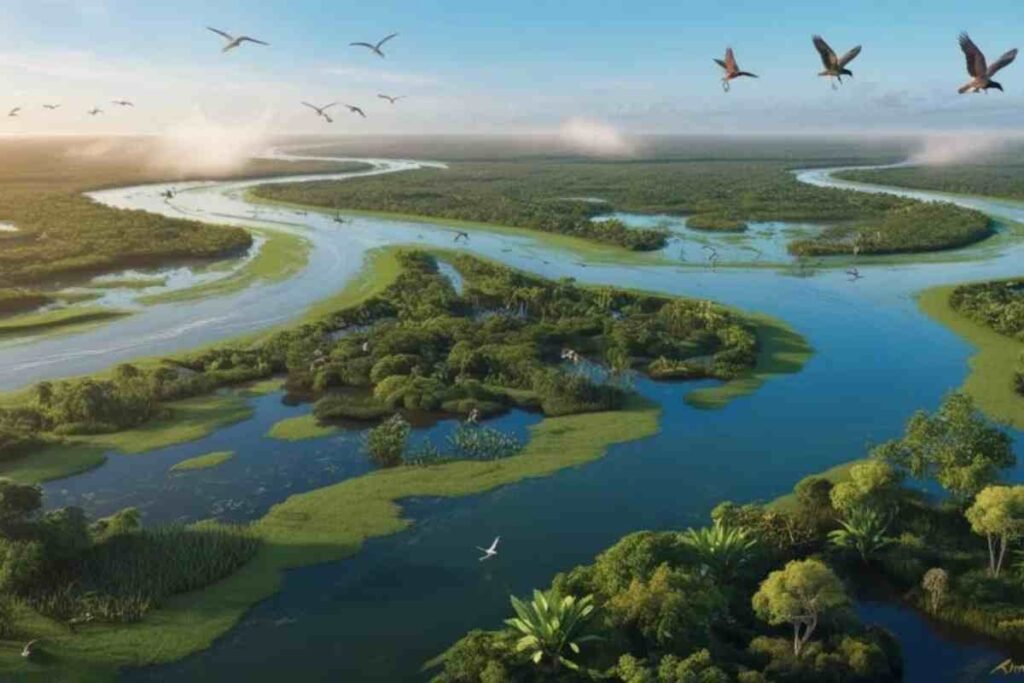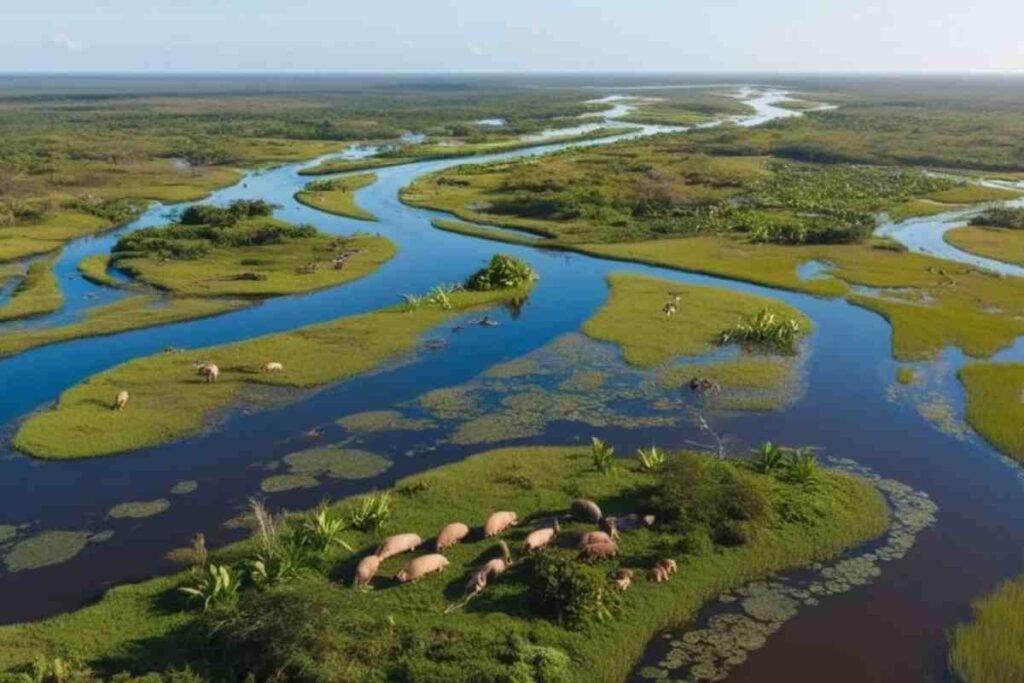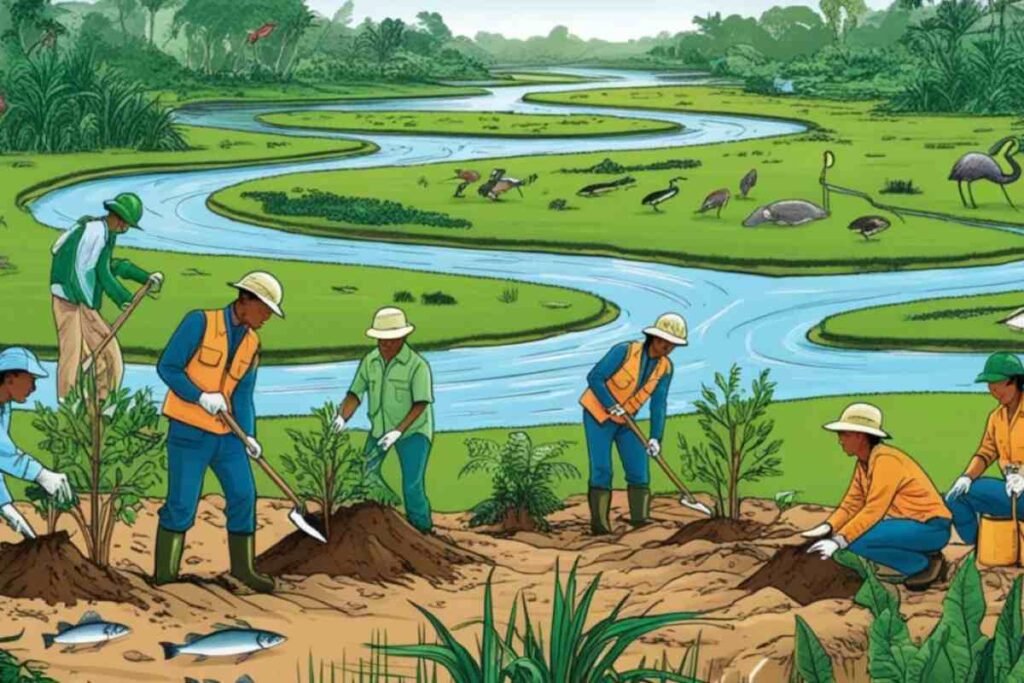The largest wetland in the world is a unique, vibrant ecosystem, home to diverse species and playing a critical role in regulating the global environment.
In this article, we’ll explore what makes the largest wetland in the world so vital, the challenges it faces, and the efforts underway to preserve its beauty and ecological functions.
What is the Largest Wetland in the World?

When we talk about the largest wetland in the world, we refer to vast, water-saturated areas where the land is permanently or seasonally submerged in water.
Wetlands can be found all over the world and exist in various forms, from freshwater marshes to saltwater mangroves.
The Pantanal in South America holds the title of the largest tropical wetland in the world, covering an incredible 42 million acres. Spanning across Brazil, Bolivia, and Paraguay, the Pantanal is an irreplaceable ecological resource.
While the Pantanal is often considered the largest, it is important to note that wetlands in other regions, such as the Siberian Lowlands in Russia and the Okavango Delta in Africa, are also significant in size and biodiversity. The Pantanal, however, stands out due to its uniqueness, biodiversity, and seasonal flooding patterns.
Why Wetlands Are Crucial to Our Planet’s Health
Wetlands, including the Pantanal, serve essential functions that affect the global environment and human life. Here are some of the critical roles these ecosystems play:
- Water Filtration and Purification: Wetlands, including the largest wetland in the world, act as natural filters by trapping pollutants and sediment, improving water quality. This function is especially critical in areas where freshwater availability is a concern.
- Flood Control: Wetlands absorb excess rainwater, helping to prevent flooding during seasonal storms. By acting as giant sponges, they slow down the flow of water, reducing the risk of damage downstream.
- Biodiversity Hotspots: Wetlands are home to more than 40% of the world’s species of plants and animals, making them some of the richest ecosystems on the planet.
- Carbon Storage: Wetlands, especially the largest wetland in the world, play a significant role in mitigating climate change by acting as carbon sinks. The plants in wetlands absorb and store carbon dioxide, helping to reduce the amount of greenhouse gases in the atmosphere.
- Livelihood for Communities: Millions of people live near or within wetland regions, relying on them for agriculture, fishing, and tourism. In places like the Pantanal, wetlands contribute billions to the local and national economies.
Importance of the Pantanal as the Largest Wetland in the World

Though wetlands exist on every continent, the Pantanal holds the title of the largest tropical wetland in the world and is also one of the most biodiverse.
Its immense size and unique ecosystem make it one of the most important and complex wetland systems globally.
- Size and Scope: The Pantanal covers a staggering 42 million acres, larger than many countries. If overlaid on the map of the United States, it would surpass the size of many states, including New York, Florida, and Wisconsin.
- Biodiversity: The Pantanal supports a vast array of species, including some of the highest populations of jaguars, caimans, capybaras, and the rare hyacinth macaw. This diversity is a result of the wetland’s unique flooding cycle, which creates dynamic environments where different species can thrive.
- Seasonal Flooding: The Pantanal’s flooding pattern from October to March and subsequent draining during the dry season provide optimal conditions for wildlife. The wetland’s waters support the life cycles of many species, providing breeding grounds, feeding areas, and shelter.
Wetlands Around the World: Other Notable Examples
While the Pantanal stands as the largest wetland in the world, other significant wetlands around the globe contribute enormously to biodiversity and the environment:
- The Okavango Delta, Botswana: One of the world’s largest inland deltas, the Okavango Delta spans approximately 6,000 square miles and is renowned for its wildlife, including elephants, lions, and thousands of bird species.
- The Siberian Lowlands, Russia: Home to the world’s largest expanse of boreal wetlands, this area contains vast marshes, peat bogs, and swamp forests that play a key role in carbon storage and climate regulation.
- The Sundarbans, Bangladesh and India: This mangrove wetland is one of the largest in the world and serves as a vital habitat for the Bengal tiger and numerous other species. It’s also crucial in protecting coastal regions from storms and erosion.
- The Everglades, USA: Known for its wildlife and unique flora, the Everglades in Florida is a vital wetland system, providing a habitat for species like the American alligator and Florida panther.
Threats Facing the Largest Wetland in the World
Despite their importance, wetlands, including the Pantanal, face severe threats from human activities and climate change. The main threats include:
- Deforestation: In the Pantanal, illegal logging and land conversion for agriculture and cattle ranching are responsible for deforestation, leading to habitat loss and increased carbon emissions.
- Pollution: Industrial runoff, untreated sewage, and agricultural chemicals are contaminating wetlands around the world. In the Pantanal, these pollutants degrade water quality, harming aquatic life and the broader ecosystem.
- Climate Change: Rising temperatures and altered rainfall patterns are impacting the flooding cycle of wetlands, including the Pantanal, which relies on its annual flood to support wildlife and plant life. Reduced rainfall and prolonged droughts could have devastating effects.
Conservation Efforts for the Largest Wetland in the World

Conservation efforts for the Pantanal and other wetlands have been a priority for governments, NGOs, and international organizations. Here are some steps being taken:
- Protected Areas: Around 5% of the Pantanal is protected as national parks and reserves. Expanding protected areas and enforcing environmental laws are key steps in safeguarding the ecosystem.
- Transboundary Conservation Initiatives: Countries like Brazil, Bolivia, and Paraguay have joined forces to protect the Pantanal through collaborative conservation initiatives like the Trinational Initiative for the Integrated and Sustainable Development of the Pantanal.
- Sustainable Practices: Promoting sustainable agriculture, ecotourism, and conservation-based practices can help mitigate the impact of human activities on wetlands. The Pantanal has become a model for sustainable eco-tourism.
- Raising Awareness: Organizations like WWF and UNESCO are working to raise awareness about the importance of wetlands and the threats they face, encouraging global action for their protection.
Conclusion
The largest wetland in the world, the Pantanal, is not just a natural wonder, but also a critical player in the health of our planet.
By understanding its significance and supporting conservation efforts, we can ensure that this vibrant ecosystem continues to thrive, providing vital services to both wildlife and humans.
The Pantanal and other wetlands around the world deserve our attention, protection, and respect, as their survival is directly linked to the well-being of our environment and future generations.
FAQs
1. Which countries share the Largest Wetland in the World?
The Pantanal spans Brazil, Bolivia, and Paraguay.
2. How big is the Largest Wetland in the World?
It covers around 42 million acres, larger than many U.S. states.
3. What kind of animals live in the Pantanal?
It’s home to jaguars, capybaras, caimans, and over 650 bird species.
4. When is the best time to visit the Pantanal?
The dry season (July to October) is ideal for wildlife viewing.
5. What makes the Pantanal different from other wetlands?
Its seasonal flooding and rich biodiversity set it apart globally.